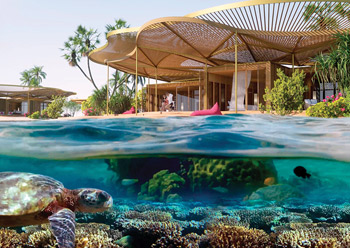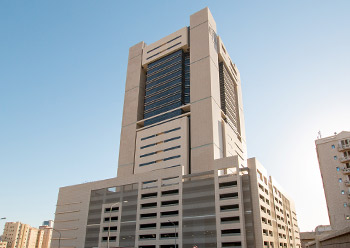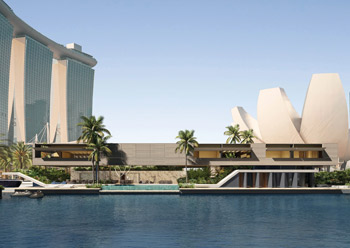
 The Coral Bloom designs take inspiration from the flora and fauna found uniquely in Saudi Arabia.
The Coral Bloom designs take inspiration from the flora and fauna found uniquely in Saudi Arabia.
A visionary plan known as ‘Coral Bloom’ created by architectural firm Foster + Partners and designed to protect, blend with and enhance the pristine natural environment at The Red Sea Project’s main hub island was unveiled last month by HRH Prince Mohammed bin Salman, Crown Prince, Chairman of The Red Sea Development Company (TRSDC).
Biodiversity considerations take centre stage within the plan, which is designed to avoid disruption of the Shurayrah Island’s mangroves and other habitats, while providing natural defences from erosion, and creating new habitats through landscaping to enhance the island’s natural state, says TRSDC, the developer behind the world’s most ambitious regenerative tourism project.
The island is one of 92 in the project’s archipelago, which is home to the world’s fourth largest barrier reef system, untouched corals and a significant number of endangered species.
 |
|
The designs for the 11 hotels are adapted to suit traveller expectations post-Covid-19. |
Foster + Partners was appointed to design 11 hotels on Shurayrah, which will see new beaches created on the dolphin-shaped island along with a new lagoon. These enhancements will contribute to raising the level of the land, providing a defensive layer from the global threat of rising sea levels. The changes aim to preserve or enhance what already exists on the island, without damaging any habitats or natural shores.
On the new concept, CEO John Pagano says: ‘Shurayrah Island is the gateway to The Red Sea Project, so it’s important that it sets the standard in ground-breaking architecture and sustainable design, not just for our destination, but globally too.”
“We expect guests to be awed by what they see when they first arrive at The Red Sea Project, enjoying a truly immersive barefoot luxury experience. The Coral Bloom designs, taking inspiration from the incredible flora and fauna found uniquely in Saudi Arabia, promise to make that vision a reality,” he adds.
The island’s natural landscape will be used to dramatic effect with all hotels and villas nestled within the landscape. The absence of high-rise buildings will ensure the spectacular vistas remain uninhibited, while creating a sense of mystery for guests as the island slowly reveals itself.
 |
|
The resorts will be created using lightweight materials with a low thermal mass. |
“The proposal outlines designs for the island’s 11 hotels, adapted to suit traveller expectations post-Covid-19 including more space, and immersed into the landscape to effectively form part of the sweeping dunes, allowing the island’s natural beauty to reign supreme,” explains Pagano.
The hotel designs have also been responsive to the changing world and traveller demands over the last 12 months. There will be no internal corridors for example, in response to a growing demand for space and seclusion following the coronavirus pandemic, he states.
The resorts themselves will be created using lightweight materials with a low thermal mass and manufactured offsite, meaning more energy-efficient construction and less impact on the environment, he adds.
Gerard Evenden, Head of Studio at Foster + Partners, says: “Our vision for Shurayrah is inspired by the island’s natural state, with the hotels designed to give the impression that they have washed up on the beaches and nestled among the dunes almost like driftwood.
“The materials we use and the low impact they have ensures that the pristine environment is protected, while the additions we make to the island serve to enhance what is already there – hence the name, Coral Bloom.”
 |
|
Shurayrah ... a dolphin-shaped island. |
“Shurayrah has incredible fauna and flora and a special relationship to its coral reefs. This is a place where you can swim off these islands and be straight into a reef. Very unusual. So, for us the first initial reaction was we want to protect the edges… What we wanted to do was to look at ways of bringing lightweight structures and placing those lightweight structures on an island.
“Just as islands have driftwood arrive and wash up onto the shore, our idea was that these hotels would wash up onto the island and then they could eventually wash away again if that was desired later. It is dealt with as a single entity with 11 hotels on it. But what we wanted to do was to try to pitch the hotels so that the hotels appeal to different people at different times of their lives,” he says, elaborating on the vision for the project.
Upon completion in 2030, The Red Sea Project will comprise 50 resorts, offering up to 8,000 hotel rooms and around 1,300 residential properties across 22 islands and six inland sites. The destination will also include luxury marinas, golf courses, entertainment and leisure facilities.








.jpg)




.jpg)




























.jpg)


































